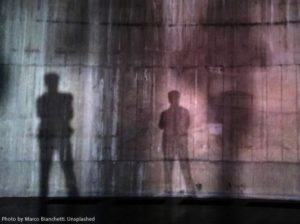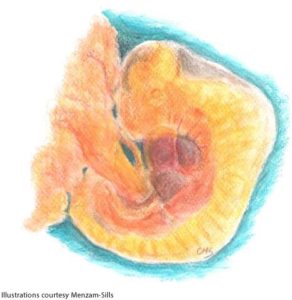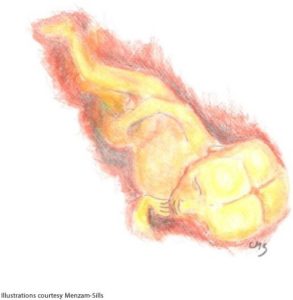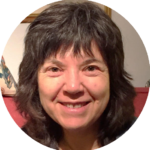Spring Issue Articles
By Cherionna Menzam-Sills, PhD, ISMETA RSMT/E, RCST
Adapted from a chapter in her forthcoming book,
Fluid and Cosmos: Embodying Our Original Embryological Potential

“Silence like a
cancer grows.” –
Simon and Garfunkle, The Sound of Silence
Shadow leaks into our lives, unconsciously affecting our perceptions, thoughts, behaviors, attitudes, relationships, bodies and personalities. Pre- and perinatal experience, rarely acknowledged or reflected during childhood, generally retreats into the unconscious, seldom coming into words and conscious thoughts. It is almost by definition shadow material.
Much of pre- and perinatal therapy orients to early traumas. While important to acknowledge, understand, and liberate from shadow, my mission in this field is to also highlight the amazing potential of little embryos in the womb developing from one tiny cell into complex individuals. How much of that potential to become also hides in shadow? How can we access and embody our original embryological potential? How can we shine the light on both the suffering and the health it may obscure?
Shadow, a term from Carl Jung, refers to unconscious qualities repressed or rejected within ourselves. Shadow aspects develop early in life in response to an inherently ambiguous world (Fairbairn, 1994). Life includes what we perceive as good as well as bad. Little ones need to perceive their relationship with mom as consistently good and safe. Even the best of mothers, however, are human. They are not always happy and do not always perfectly meet the child’s needs and expectations. Pregnant women experience stress, loss, and life, passed on to the prenate biochemically and energetically. The field of mother inevitably includes both nourishing and toxic elements. To tolerate such ambiguity, little ones develop a split self system, some aspects organizing around feelings of goodness and others around feelings of badness.
Shadow generally relates to feelings of badness. Little ones experiencing anger, terror, hatred or disgust toward abusive or toxic parents experience a double bind. Their life depends on mother and her caring acceptance. Rejecting or withdrawing from her means death. Survival requires opening to her, rejecting or withdrawing from unacceptable feelings. Even in the womb, babies may try to stay invisible to avoid being discovered by a rejecting mother. Invisibility and hyper-vigilance can become part of the developing personality.
Rejecting or withdrawing from her means death. Survival requires opening to her, rejecting or withdrawing from unacceptable feelings. Even in the womb, babies may try to stay invisible to avoid being discovered by a rejecting mother. Invisibility and hyper-vigilance can become part of the developing personality.
Hidden feelings, however, do not disappear. They remain in the child’s psyche as shadow. Some shadow aspects relate to feelings of goodness. Unwanted children, or those feeling unloved, unwelcomed or neglected, may assume they are bad or undesirable, denying their innate goodness. They may act out their sense of badness, unconsciously fulfilling their early belief. Inherent qualities become hidden behind a façade presented to the world. Little ones often stay good or quiet to take care of mother. They become fetal therapists, overly sensitive to (m)others’ needs, or they try to please by acting as expected. Something in them begins to die in the process.
When it is painful or dangerous to expose our true nature, we protect it, eventually forgetting what we hide. The scar remains. What is covered leaks  out without awareness. Have you ever noticed a hint of fear or anger in the eyes of someone always presenting as confident and happy? Dr. William Emerson (1996) calls these “shadow leaks.
out without awareness. Have you ever noticed a hint of fear or anger in the eyes of someone always presenting as confident and happy? Dr. William Emerson (1996) calls these “shadow leaks.
Sounds of Silence Speaking
And the vision that was planted in my brain
Still remains
Within the sound of silence
Shadow remains in the darkness of our psyche. Unacknowledged prenatal and birth experience haunts our dreams, visions, and perceptions, often expressed and recapitulated through behaviors, gestures, postures, relationships, etc. Prenatal and birth images abound in art, dance, theater and more, apparently unconscious efforts to express and complete unfinished business. To Jung artistic expression, or “active imagination” resembles dreams in its symbolic portrayal of our personal history unconsciously seeking resolution (e.g. Chodorow, 1997).
People talking without speaking
People hearing without listening
People writing songs that voices never share
No one dared
Disturb the sound of silence
The agreed upon silence about pre- and perinatal experience in modern western culture is fortunately changing, thanks to pioneers in the field of pre- and perinatal psychology and efforts to disseminate education about this topic. For most of us, however, attempts to express our prenatal and birth experience were dismissed, ignored or aggressively silenced. Toddlers attempting to speak about their time in the womb or birth are often hushed, ridiculed, or ignored. Children’s memories develop in relation to how they are reinforced or not by those around them. They are learning how to behave within the culture they have been born into. Similar to those who have experienced sexual or other abuse with messages to remain silent about it, the memories remain in the body but may not be integrated into consciousness because of lack of opportunity. Shadow attempts to get our attention, seeking healing and integration. Early material seeps into our lives in devious or unsuspected ways.

Shadowy Potential
What shadow aspects do you hold in darkness? How do you continue to embody your early experience? A toxic womb experience may be expressed through allergies or other sensitivities. Or the individual affected may become an environmental activist. A difficult birth may be reflected in finding new beginnings similarly difficult. Consider, however, the inherent power it took to push your way through the birth canal, if you did that. What health and intelligence guided your prenatal development, perhaps surviving intense umbilical toxicity? What strengths do you not see yourself as having? Or do others see in you? The shadow we don’t see in ourselves is often obvious to others. Can you consider embracing and receiving the magnificent being emerging at your birth? If you missed being welcomed then, it is not too late to welcome yourself now. If this is difficult, I recommend finding a therapist you can resonate and feel safe with to begin exploring this.
Investigating what is unconscious and unspoken about your early history may revive or even save your life. “Silence like a cancer grows.” Exploring, playing, writing, singing, dancing, and listening to our dreams and each other, is quite different from growing cancer. We can grow health and aliveness. I wish this for you and for all of us.
References
Chodorow, J. (Ed.). (1997). Jung on active imagination. Princeton, NJ: Princeton University Press.
Emerson, W. R. (Speaker). (1996). Introduction to the shadow (Video recording). (Available from Emerson Training Seminars, 4940 Bodega Hwy., Petaluma, CA 94952).
Fairbairn, W. R.D. (1994). Applications and early contributions. In D. E. Scharff and E. F. Birtles (Eds.), From instinct to self: Selected papers of W. R D. Fairbairn, Vol. 1-Clinical and Theoretical Papers (The Library of Object Relations).
 CHERIONNA MENZAM-SILLS began teaching Embryology through Movement in 1997 as part of her doctoral studies in Pre- & Perinatal Psychology.
CHERIONNA MENZAM-SILLS began teaching Embryology through Movement in 1997 as part of her doctoral studies in Pre- & Perinatal Psychology.
Cherionna was authorised in 2007 as a Continuum teacher by Continuum founder Emilie Conrad. She also practices & teaches Biodynamic Craniosacral Therapy around the world, often with her husband, Franklyn Sills. Biodynamics involves perceiving and augmenting embryological forces to support health and well-being throughout the life span.







